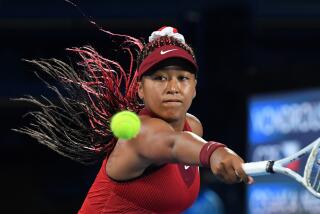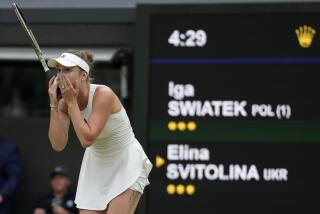Navratilova Confident of Regaining No. 1 Spot
- Share via
WASHINGTON — The victory had been predictable for Martina Navrtilova -- a straight sets dismissal of little-known Austrian Judith Wiesner in the first round of another stop on the women’s professional tennis tour.
The first question in the post-match press conference was equally predictable, so much so that Navratilova answered it before anyone asked.
“I don’t plan on retiring any time soon,” she offered. “Next question.”
To Navratilova, age 31 is no time for retirement. Rejuvenation? Now that’s a different question.
“I know I still haven’t played my best tennis,” said Navratilova, a scary thought considering she has been the dominant player of the decade and perhaps the best player of all-time. “I was surprised that I was being written off so quickly. I know my capabilities and I would think that the people would know them, too, after all these years. But it’s OK. I haven’t gotten the No. 1 ranking back -- yet.”
Therein lies the burning desire that has created a new and improved Martina Navratilova. She desperately wants to regain the No. 1 ranking that West German 18-year-old Steffi took from her last August.
Navratilova revolutionized women’s tennis in the 1980s with an unprecedented commitment to fitness, forcing a heightened level of athleticism from any player who hoped to reach the top.
Graf, who was 5 when Navratilova became a professional and had just turned 9 when Navratilova first ascended to No. 1, is a member of the first crop of young professionals who benefitted from Navratilova’s trail-blazing.
Navratilova, however, isn’t ready to become merely a role model for a conquering generation of players. She claims she is destined to be No. 1 again.
“I guess I feel like it belongs to me. I just don’t have it right now. It’s hers right now. I just want to get it back. It was mine for a while -- she’s got it now and it’s something that I’d very much like to have back,” Navratilova said.
“But to do that, I have to win all the other tournaments besides just beating her, which is a task in itself. But I’m looking forward to playing her again.”
With a new coach and newly healthy knees, she won the Virginia Slims of Dallas, the Virginia Slims of California and the Virginia Slims of Washington in consecutive weeks while playing what she called the best tennis of her career.
“I think she’s really positive -- much more positive -- and believes more in herself than last year,” said Hana Mandlikova, ranked sixth in the world.
“She’s hit a streak where she’s back playing very confident tennis. When she’s confident, it’s tough to beat her,” added Pam Shriver, Navratilova’s doubles partner who was a straight sets victim in the finals at both Dallas and Washington.
“I don’t think she could challenge Graf in a full year playing the way she did last year. Now, I think she can challenge and regain her ranking by the end of the year if she maintains this level. But maintaining levels is not an easy thing to do, particularly when you’ve been playing a very, very long time.”
Navratilova has played a very, very long time, comparatively speaking, and reigned as No. 1 in the world in the year-end rankings in 1978 and 1979 and from 1982 to 1986. But Graf took the top spot Aug. 16, 1987.
“I knew that I had to make some changes and some adjustments, so I did,” Navratilova said.
She ended her association with Mike Estep, her coach for the previous four years, then went through two more coaches, Randy Crawford and Renee Richards, before settling on former tour pro Tim Gullikson.
Gullikson, known primarily for playing doubles with twin brother Tom, retired from the tour in 1986.
“Even as little as he’s seen these women play, he’s still come up with some good ideas at how to play them already,” Navratilova said. “Technically, he’s helped me with every stroke we’ve worked on. I’m enjoying it because I’m hitting the ball hard and I’m able to create a lot more on the court.”
Another hindrance in 1987 was Navratilova’s persistent knee problems. As a remedy, she gave up basketball to reduce the wear and tear on the knees.
While she proclaims herself mentally and physically prepared for a duel with Graf, Navratilova may get only four more shots at her in the rest of 1988 (the French Open, Wimbledon, the U.S. Open and the Virginia Slims Championships) because of the scheduling policies of the Women’s International Tennis Association.
As a result, the point system used to determine the rankings favors Graf. “I don’t even worry about the points. I don’t even look at them,” Navratilova said. “It doesn’t matter if it’s April or it’s November, but if I keep playing like this it will be this year. I just need to keep winning, beating everybody else. I’m looking forward to playing Steffi. I’m up to the challenge.”
Navratilova holds a 7-3 career edge on Graf, winning the last two meetings in the finals of the U.S. Open and Wimbledon last year. Those were the only two losses Graf suffered the entire year.
“For five years, there I was (at No. 1) and everyone was shooting for me. Now the pressure is on Steffi, rather than on me, so I have someone to gun for,” Navratilova said.
The 5-foot-8, 145-pound Navratilova defected from Czechoslovakia to the United States and in 1981 became a U.S. citizen. She lives in Ft. Worth, Texas.
She has built her success upon a smothering serve-and-volley attack, remarkable athleticism and intense competitiveness.
More to Read
Go beyond the scoreboard
Get the latest on L.A.'s teams in the daily Sports Report newsletter.
You may occasionally receive promotional content from the Los Angeles Times.










